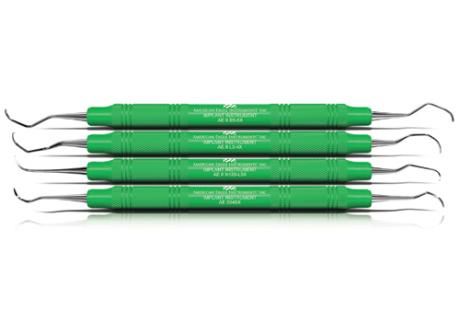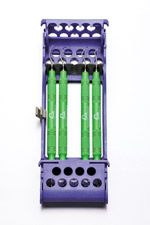The science behind instrument selection
Hygienists have different needs, depending on their day-to-day practice. As a hygienist in a practice that specialized in placing dental implants, I had to find instruments that worked well to clean the surfaces of the abutments, crowns, threads and overdenture bars thoroughly, without the worry of scratching the surfaces of the restorations, which causes bacterial adhesion and can lead to peri-implantitis or, worse, implant failure.
The Rockwell Scale is the key to evidence-based instrument selection for dental implant maintenance.

As clinicians, we are often faced with the decision to determine which products or instruments are best for our practice and our patient’s needs.
Hygienists have different needs, depending on their day-to-day practice. As a hygienist in a practice that specialized in placing dental implants, I had to find instruments that worked well to clean the surfaces of the abutments, crowns, threads and overdenture bars thoroughly, without the worry of scratching the surfaces of the restorations, which causes bacterial adhesion and can lead to peri-implantitis or, worse, implant failure.
After an item is created, the surface is mechanically flawed with tooling marks and scratches. Many of these surface flaws can be reduced by methods of polishing, tumbling and electropolishing but surface imperfections will likely still exist. The implant will have a higher risk for being damaged (and bacteria-prone) during construction than during cleaning, but I still wanted to reduce the risk as much as I could.
I wanted a set of instruments that would work to remove the biofilm and hard calculus buildup on the implants without scratching them. I couldn’t believe the claims of instrument manufacturers without unbiased research to support their claims. In the process of conducting my own research and clinical trials, I found titanium implant instruments from American Eagle.
Medical-grade instruments
American Eagle Instruments were on the forefront of bringing medical-grade titanium instruments to the implant maintenance market. Like me, educators and clinicians worldwide wanted evidence that the titanium was safe to use around the surfaces of dental implants. This claim could be measured using a Rockwell C scale (HRC).
Developed by American metallurgist Stanley P. Rockwell, the Rockwell scale is “a hardness scale based on indentation hardness of a material.” The resistance to penetration correlates with the material’s resistance to scratching, critical when choosing which instrument to use during implant maintenance appointments. We want to avoid leaving trace elements from the instrument on the implant surface so not to alter the biocompatibility.

Because plastic instruments are softer than titanium, a Rockwell B scale (HRB) is used to compare titanium accurately. The reading of plastic implant instruments was 11.8 on the Rockwell B scale. HRB values need to be around 100 to cross over to a value comparable to American Eagle’s titanium scalers.
In 2013, American Eagle Instruments performed clinical testing in order to prove that their titanium instruments were indeed softer than titanium implants. HRC values were determined for American Eagle implant instruments, as well as most of the leading manufacturers’ instruments for a comparative analysis. Not all commercially available titanium instruments were measured, but a cross-section of the major manufacturers was used as a sample size.
Initial trials concluded that American Eagle and most of the other leading manufacturers tested were actually harder than the implant HRC values and could cause scratching. As a response, American Eagle decided to design a titanium instrument that was softer than most implant substrates on the market, yet rigid enough to remove biofilm and calculus without damaging the implant surface.
Titanium is extremely malleable so instruments can be hardened or softened to ensure that they are within the proper values on the Rockwell C scale to be softer than the implants themselves. The base substrate of the American Eagle titanium instruments needed to be softened to avoid causing scratches. Rather than soften the titanium, which may have resulted in compromising the integrity of the instrument, it was decided to switch substrates completely to a commercially pure (CP) Grade 4 titanium.
This new substrate could have a lower HRC value than the implant, but still be strong enough to be effective. The original American Eagle titanium instrument model had an HRC value of 31.9. The instruments with CP Titanium Grade 4 were found to have a HRC value of 23, proving that the re-designed titanium implant instruments minimized or eliminated the risk of bacterial contamination due to scratches on the implant.
Tested by hygienists
In an effort to ensure that there was no significant clinical difference in performance between the new instruments (HRC 23, purple handle) and the original instruments (HRC 31.9, green handle), 15 registered dental hygienists (including the writer), were given both sets of instruments to use for 90 days before reporting their findings. The report included:
• How long the hygienist has been in practice
• How many patients with dental implants the hygienist sees per week (on average)
• Where on the implant the hygienist primarily works
• How the hygienist felt about other implant instruments available on the market
• What the hygienist currently uses or prefers to use
• What the hygienist thought about the blade width of the American Eagle titanium instruments
• Which of the American Eagle titanium implant instrument sets the hygienist preferred using
• Whether the hygienist noticed a difference in the performance
The data showed that when comparing the overall performance of the HRC 23 instruments compared to the HRC 31 instruments:
• 30.77% of clinicians could not tell a difference
• 38.46% of clinicians preferred the HRC 23
• 23.08% of clinicians preferred the HRC 31.9
• 76.92% of clinicians felt the HRC 23 instruments were as effective as or better than the HRC 31.9 instruments in their overall performance
I personally loved the design options of the American Eagle titanium instruments. The implant maintenance set covers all aspects and angulations needed to help patients maintain their implants. The HRC 23 titanium instruments are strong enough to remove tenacious calculus and biofilm, yet soft enough to keep from scratching or damaging the implant surfaces. I highly recommend American Eagle titanium implant instruments to anyone looking to be at the top of their game when it comes to worry-free implant maintenance instrumentation.
ABOUT THE AUTHOR

Angela M. Fuller, RDH, BA, received a bachelor’s biology and business administration from Western State Colorado University in Gunnison, Colo. She then went on to pursue her passion for dentistry, receiving her associate’s degree in dental hygiene from Pueblo Community College in Colorado. Active in ADHA on the local, state and national level, Fuller has enjoyed being a part of shaping the profession of dental hygiene’s practice acts and bylaws. She has a passion for learning and educating and loves the clinical aspect of dental hygiene.